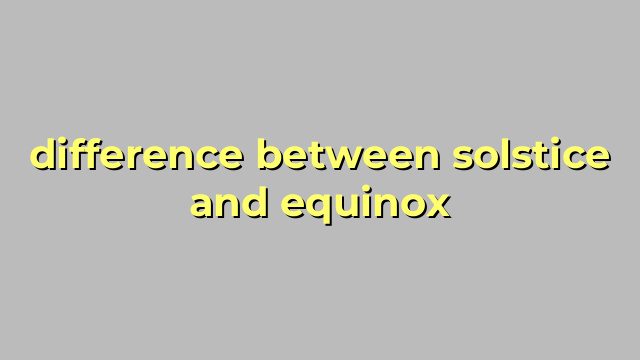Difference between Solstice and Equinox
When it comes to the changing seasons and the positioning of the sun, two terms that are commonly used are solstice and equinox. While these events may seem similar, they actually have significant differences. Here, we’ll look at what each event is and how they differ from each other.
What is a Solstice?
A solstice occurs twice a year, marking the point at which the sun reaches its highest or lowest point in the sky. There are two types of solstices: the Summer Solstice (around June 20-22) and the Winter Solstice (around December 21-23). During the Summer Solstice, the sun is at its highest point in the sky and the days are the longest they’ll be all year. During the Winter Solstice, the opposite occurs, and the sun is at its lowest point in the sky, making the days the shortest they’ll be all year.
What is an Equinox?
An equinox also occurs twice a year, but it marks the point at which the length of day and night is equal or close to it. There are two types of equinoxes: the Vernal Equinox (around March 19-21) and the Autumnal Equinox (around September 22-24). During the Vernal Equinox, the sun crosses the equator from south to north, marking the beginning of spring in the Northern Hemisphere and fall in the Southern Hemisphere. During the Autumnal Equinox, the sun crosses the equator from north to south, marking the beginning of fall in the Northern Hemisphere and spring in the Southern Hemisphere.
Differences between Solstice and Equinox
The main difference between solstice and equinox is the way they mark the positioning of the sun. Solstices mark the point at which the sun is at its highest or lowest point in the sky, while equinoxes mark the point at which the length of day and night is equal or close to it. Additionally, solstices mark the beginning of summer or winter, while equinoxes mark the beginning of spring or fall.
In conclusion, while solstice and equinox may sound similar, they are distinctly different. Understanding the differences between these events can help you better appreciate the changing seasons and the position of the sun in the sky.
Table difference between solstice and equinox
| Solstice | Equinox | |
|---|---|---|
| Definition | The solstice is the day with the shortest or longest period of daylight, depending on the hemisphere. | The equinox is the day with equal periods of daylight and darkness. |
| Date | Occurs twice a year, around June 20-23 and December 20-23. | Occurs twice a year, around March 20-21 and September 22-23. |
| Effect on seasons | The solstice marks the beginning of summer or winter in the respective hemisphere. | The equinox marks the beginning of spring or autumn in the respective hemisphere. |
| Duration of daylight | The duration of daylight is the shortest or longest of the year. | The duration of daylight and darkness are equal. |
| Cultural significance | The solstice has been celebrated in many cultures as a symbol of the cycle of life and the return of light. | The equinox marks the halfway point between the solstices and has been associated with themes of balance and harmony. |

